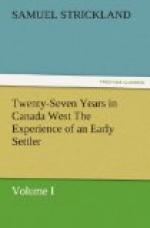Wheat . . . . . 292,949 bushels.
Barley . . . . . 13,012 "
Rye . . . . . 2,181 "
Oats . . . . . 215,415 "
Peas . . . . . 54,657 "
Indian Corn. . . . 5,352 "
Potatoes. . . . . 210,913 "
Buck-wheat . . . . . 673 "
Mangel-wurzel . . . . 297 "
Turnips . . . . . 143,725 "
Hay . . . . . 12,823 tons.
Flax or Hemp . . . . 7,359 pounds.
Maple Sugar. . . . 351,721 "
Wool . . . . 54,347 pounds.
Fulled cloth . . . 10,303 yards.
Linen, or cotton cloth 1,197 "
Flannel, or other unfulled cloth 41,397 "
Cheese for Market . . 7,761 pounds.
Butter for Market . . 58,873 "
Beef, or Pork for Market 1,308 barrels.
“And they further rejoice in the possession of the following stock:—
Neat Cattle . . . 26,260 Horses . . . . . 2,646 Sheep . . . . . . 20,022 Hogs . . . . . . 14,655
“The above gratifying examples speak loudly for the industry of the settlers; and where hired labour can, with difficulty, be obtained at a high remuneration, notwithstanding the yearly increased ratio of new comers, and, moreover, where all are diligently employed in the onward march to happiness and independence, we may truly be thankful to a superintending Providence, that prosperity is in the ascendant.”
Mr. Lizars states in another part of his Report, that the population of the Huron district
In 1841, was . . . . . 5,600
In 1847, six years afterwards 16,641 increase 11,043
In 1848, one year do . . . 20,450 " 3,807
In 1850, two years do. . . 26,933 " 6,483
According to this ratio of increase, we may safely infer the population at the present time (1852), to exceed thirty-two thousand souls; an increase almost incredible; as, upon reference to Smith’s Work on Canada, it will be found that the Huron district has made more rapid progress since its first settlement in 1827, than Lower Canada did in one hundred and four years; its population then being (in 1721), 24,511.
Many contradictory statements have been made and published in respect to what is the real actual grain average of Canada West. My own opinion is, that even could a truthful average be obtained, it would throw very little light on the real capability of the land—and for this reason. One-half of the emigrants who settle upon land in Canada, and adopt cultivation as their employment, are weavers, tinkers, tailors, sailors, and twenty other trades and professions. It must be the work of years to convert such settlers into good practical farmers. In such cases, how can a fair yield be extracted from land ignorantly cultivated? But I will venture to affirm, that wherever good farming is in practice, as good an average yield will be obtained, as in any country in the world.




